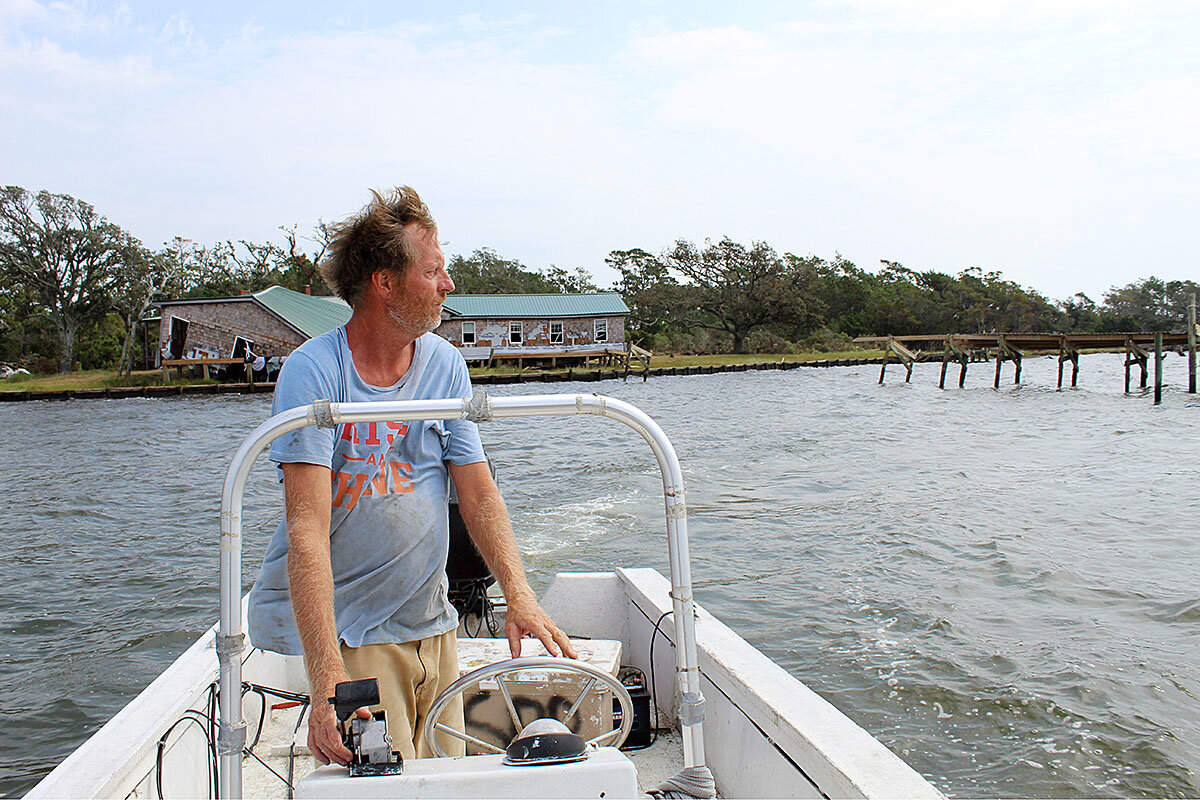Buddy Brittingham filled his flounder skiff with bleach jugs, stacks of toilet paper, kitty litter, cases of water, and SpaghettiOs until it almost sank.
The fisherman-turned-florist then set his bow toward sea, racing to help some 800 hurricane-riders in desperate straits after Hurricane Dorian threw a high elbow to Ocracoke Island on the Outer Banks as it skated off toward the Canadian Maritimes.
As he skipped the 22 miles across Pamlico Sound with his cousin Cayton Daniels, the duo joined a flotilla of charity so overwhelming that emergency managers on Sunday had to warn that craft would be turned back.
“It was quite a sight, watching all those boats coming in from all over to help,” says Mr. Brittingham.
And like many Cedar Islanders, Mr. Brittingham recalls a similar sight a year ago when a flotilla from Ocracoke raced to shore to resupply communities like Sea Level and Atlantic that still bear heavy scars from Hurricane Florence.
It is perhaps a truism of dire times: The more remote the place, the deeper the kinship.
The ticktock of powerful Atlantic cyclones along North Carolina’s coast is part historical, part geographical. But as climate scientists warn of increases in storm frequency and intensity, the humanitarian situation on one of America’s most storm-wracked communities highlights not just rising national challenges, but the evolution of response – including, locals say, the exponential benefits of reciprocity.
“The reciprocation has been tenfold,” says Ocracoke resident Helena Stevens. “What happened was monumental and unprecedented, and we have not dealt with this before. There is disbelief that this kind of storm happened and did the damage it did, which adds to the level of gratitude for the help and assistance.”
Islander character
Resourcefulness and ruggedness have defined life on Ocracoke since the Hatteras Indians used it for subsistence fishing and taught the colonists to brew a bracing tea from an island holly. It’s where Sir Walter Raleigh ran his ship, The Tiger, aground, and where the pirate Edward Teach – Blackbeard – met his end in a fierce battle with British sailors.
Early inhabitants were pilots who helped ships navigate treacherous sounds. Locals speak a vanishing brogue called High Tider – “Hoi Toider,” phonetically – and the town didn’t formalize its street names until 1999.
Everything from gales to major hurricanes – including megastorms in 1933 and 1944 – are recorded on the walls of the Hurricane House, a local residence that’s testament to barrier island survivalism.
Moreover, Ocracokers helped pioneer hydrostatic vents that allow water to flow into and then away from flood-prone buildings – a necessary innovation on a gale-prone island that averages only 5 feet above sea level.
But it’s not bravura that makes them ignore mandatory evacuation orders. “They simply believe in staying,” says Cedar Island fisherman Jeff Styron, who evacuated.
But when Cedar Island resident Buddy Goodwin approached the Ocracoke dock on Sunday with supplies, he was met by an unusual sight – visibly shaken islanders, overcome by gratitude.
“There were tears to fill buckets,” he says.
“The islanders are overwhelmed not only with the incredible amount of destruction ... but also brought to tears by the incredible outpouring of love and donations,” adds Amy Howard, who manages the Village Craftsmen store on Ocracoke, in an email.
Dorian rode an infernal arc across the Atlantic, berating the Bahamas for 48 hours as a Category 5 storm before it marched up Florida’s east coast, past the Georgia and South Carolina Sea Islands before finally glancing off Cape Hatteras. In stark contrast to the lives lost in the Bahamas, no Ocracoker perished.
“Ocracoke Island is a very tight knit community and [people are] very proud of their island,” says Ms. Stevens, who is executive director of the Ocracoke Civic and Business Association. “It’s a super-special place, one that you don’t find in today’s world. Families have been there for hundreds of years. But it’s a community now completely reliant on tourism, so it’s important that we get the assistance we need to rebuild.”
Yet the devastation is near complete. Homes, hotels, boats, cars, and belongings – all wrecked.
“It’s the worst I’ve ever seen it,” says Gene Springle, who made the dash across the sound with his 12-year-old son, Dakota.
Recovery continued Monday as people who evacuated were allowed to begin to return despite lack of power and potable water. Hyde County emergency managers urged people to contact authorities before approaching the island with supplies.
Recovery resources for the new normal
A flood of people wanting to help may seem like a good problem to have, but it poses a challenge for emergency responders struggling to ensure that ad hoc crews of well-meaning volunteers don’t disrupt official rescue and relief efforts. As storms intensify, so too, it seems, does the desire of people to help one another.
“Given climate change and what’s happening with storms globally, this is probably our new norm, and what happens to a lot of local economies in these coastal communities is going to depend a lot on how we adapt to this,” says Frank Lopez, extension director for North Carolina Sea Grant, at N.C. State University in Raleigh, and an expert on community resiliency. “This is the condition we have to now deal with.”
“We have always had faith-based groups that have been great about helping neighbors, but now we are starting to see communities themselves creating organizations to assist in disaster,” adds Mr. Lopez. “That trend took off in the recovery from Florence and we’re seeing it again here. And being as this is the new normal, we’re going to have to help ourselves.”






